The EFL League One is known for being highly physical and competitive, making it very difficult to earn promotion to the Championship.
However, on occasion, along comes a team that seems to defy that difficulty with consistent quality, which leads to consistent results.
This season, we have seen just that from Steven Schumacher’s Plymouth Argyle, who sit atop League One at the time of writing, 10 points clear of the play-off zone.
They aren’t the only team who has shown consistent quality, though, with former Premier League club Sheffield Wednesday just three points behind Argyle, with a game in hand as well.
But Plymouth is not likely to panic at the thought of this. They have been arguably the best team in the division all season, losing just three times so far.
In fact, they have lost just once in the league since August!
So they hold their future in their own hands and need to continue on the same road of form to complete their mission of getting out of League One.
Argyle’s biggest asset this season has been their clinical nature in attack – Schumacher’s side have netted 51 goals in 28 games in the league thus far, which is the highest in the division.
Plymouth has displayed variety when it comes to Steven Schumacher’s preferred formation—3-4-2-1 has been their most frequented shape, but they are also partial to 3-4-1-2 and 4-4-2.
In this scout report, we will provide a tactical analysis to highlight the key elements of Plymouth’s
attack tactics, particularly their build-up play through the thirds. We will also analyzean area of concern at the back.
Steven Schumacher Tactics – Playing through the thirds
Steven Schumacher’s style of play has earned heaps of praise throughout this campaign, not only for getting the best out of his players but also for his brand of football, which is easy on the eye.
His Argyle side prefers to play patiently from the back when it’s possible, playing short passes to reach the midfield third before looking to exploit spaces in the opposition’s midfield and defensive thirds.
It is worth noting that Plymouth is aware that these tactics don’t work against every opponent and has shown the adaptability required to get results.
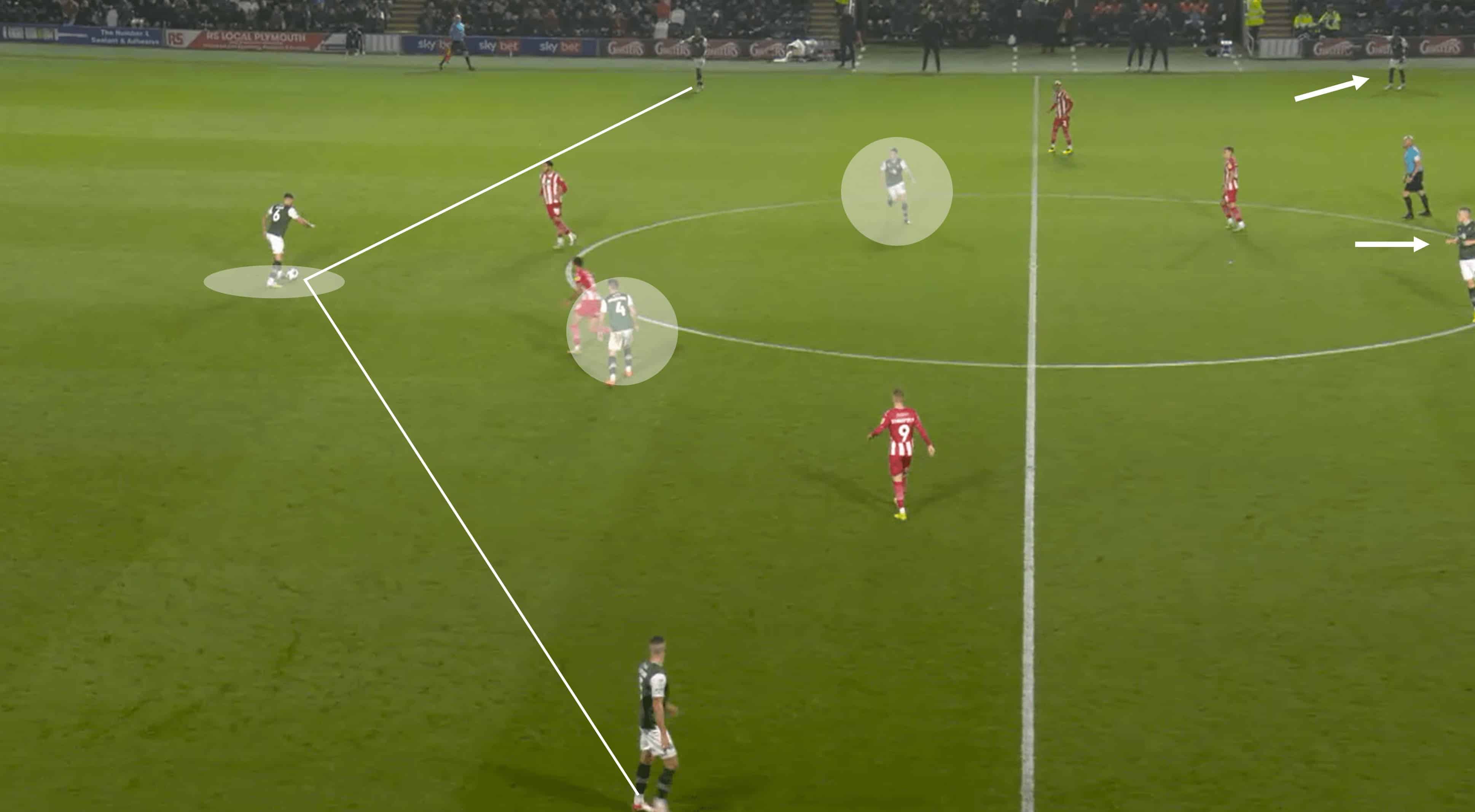
Argyle doesn’t always dominate the game in terms of possession (although it does happen on occasion)—their average possession per game so far this season is 52.4%.
However, even in games where possession is more even than others, Plymouth will still look to implement its patient style of play. The image above shows the shape they aim for when their back line is nearing the halfway line.
A great deal of width between the three central defenders, who can both be used as outlets to progress the play and support from two central midfielders give Plymouth more options going forward, similar to how Tottenham Hotspur plays.They also look to stretch the opponent to create space further up the pitch and do so by having a presence in the centre and on both flanks.
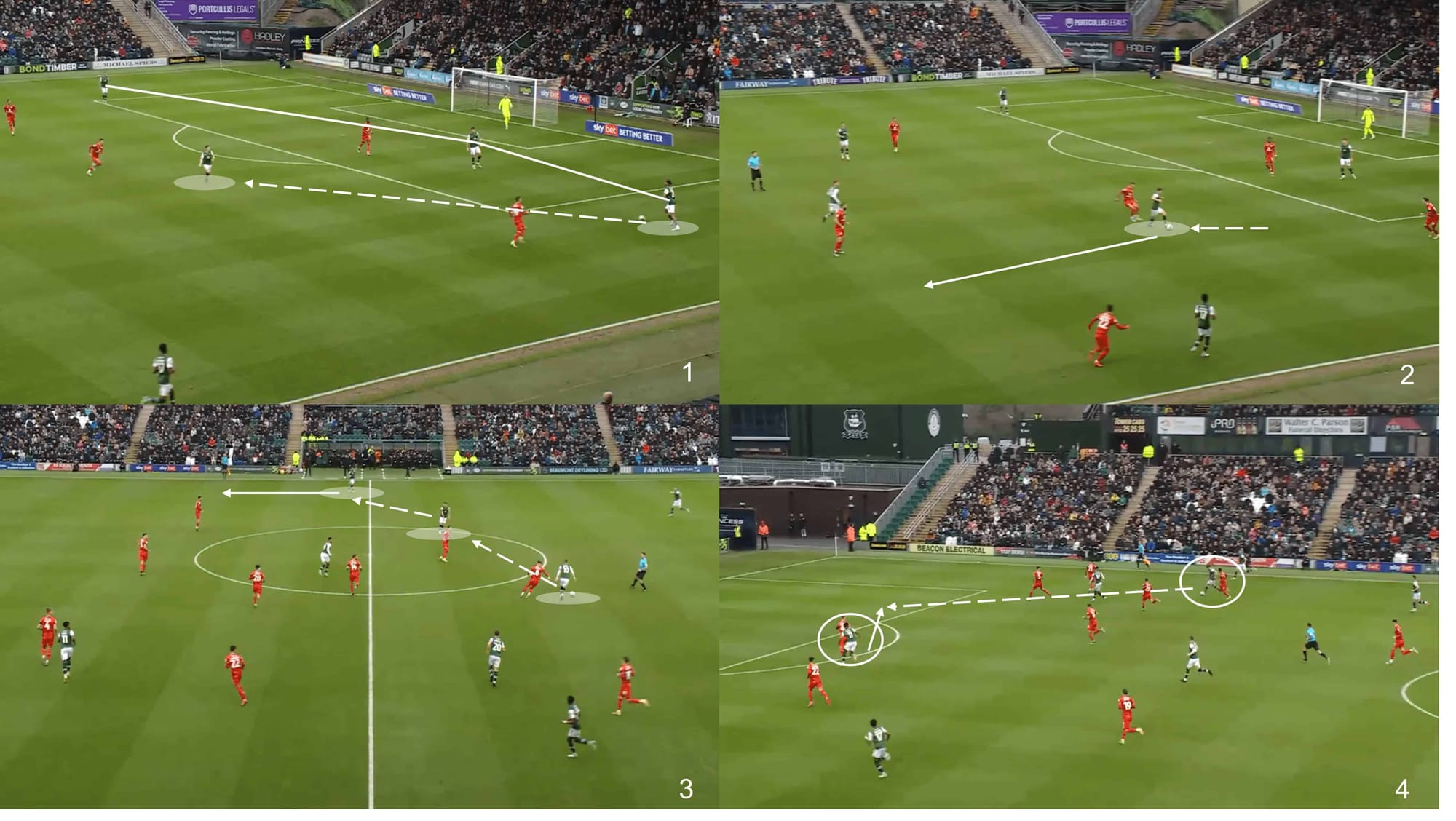
This next analysis gives us a breakdown of an example of Plymouth playing out from the back and turning possession from deep inside their own half into a chance on goal—something that has become a feature of their play.
They begin with the ball just wide of their own box—note the width of the back three again to give them those outlets and stretch the opposition.
The pass goes into the arriving midfielder without hesitation, and the man in green shows a wonderful individual ability to knock the ball forward using a clever turn, allowing him to break away from the opponent.
Side note: At this level especially, a tactical base is wonderful, but you often need individual quality to get things done.
After arriving in the midfield third, we see a familiar Plymouth action as they shift the ball across the pitch over to the opposite flank.
In the example above, they do this with a series of short lateral passes, but they have been known to achieve the same goal with long switch passes.
Once the ball reaches the right flank, there is more space to attack as the opposition is still adjusting from the opposite side.
This is when Plymouth ups the pace of their attack and tries to break into a goalscoring opportunity, which is what they do above.
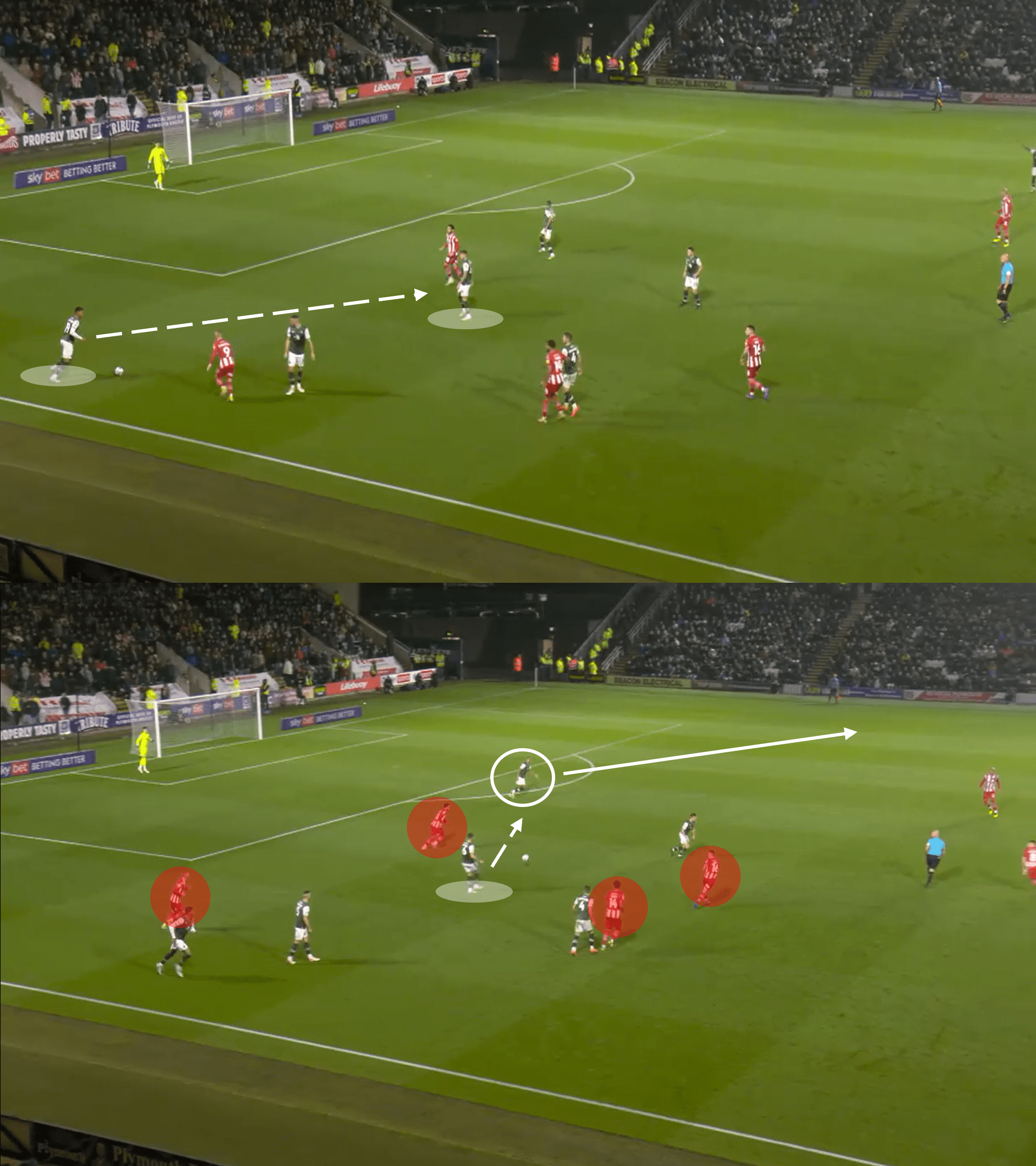
Even the best teams aren’t perfect, and Plymouth is no exception.
They sometimes find themselves under pressure.
Yet they still look to play out of danger first, only clearing their lines when it becomes absolutely apparent that it won’t be possible.
Borrowing the principles of the move from the previous example, they play out by using a central option as the bridge between one side and the other, playing the pass out towards the left-sided CB, who then has the space to drive forward into the left flank, despite the heavy opposition presence.
The Plymouth players’ confidence and understanding of how to play out of danger in this way speak volumes about the work Schumacher has done.
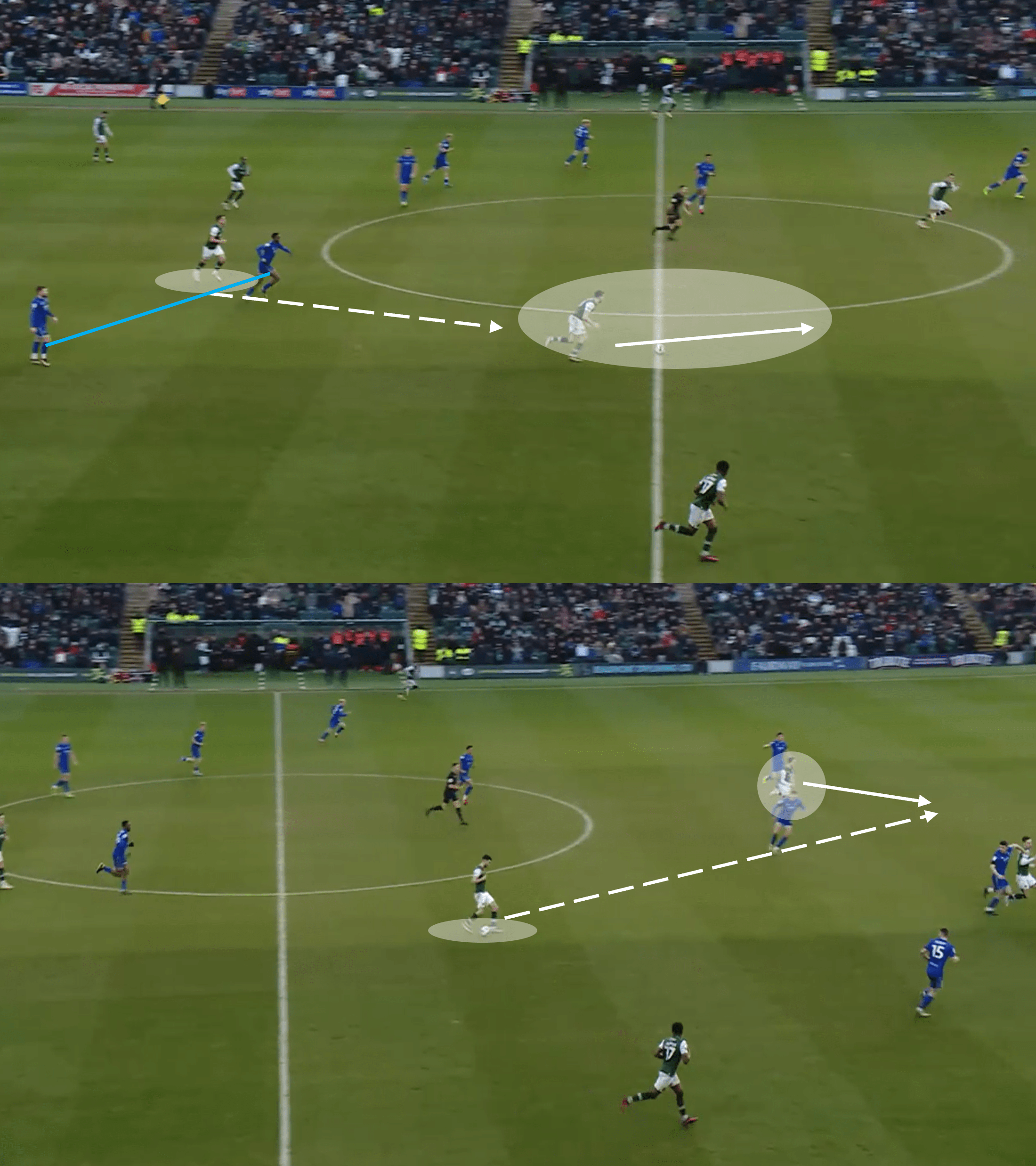
These tactics of playing through the thirds can be utilised more directly to carve through the opposition, too, particularly following a transition, which means they will be temporarily out of shape.
In the image above, the Plymouth midfielder cuts a clever blind pass through the two nearby opponents to find his teammate in acres of space as he enters the opposition half.
While he does have plenty of room to drive into himself, he shows good awareness and vision to spot the run of his attacking teammate, who makes an inverted run into a gap in the defence.
The run is met by a perfectly weighted and well-timed pass, with the forward going on to put the ball in the back of the net.
This shows that Plymouth’s game has an element of variety while still maintaining the principles and adhering to the gaffer’s instructions.
Outperforming their xG
Goals win games, there’s no doubting that.
At the time of writing, Plymouth has the best-attacking record in the division, which is a massive part of why Argyle is sitting pretty at the top of the league.
They are also currently outperforming their xG record – their average xG per 90 is 1.57, yet they average 1.82 goals, highlighting a real attacking danger with the ability to create chances of nothing.
This comes down to the belief and cohesion within the ranks, which breeds momentum in attack.
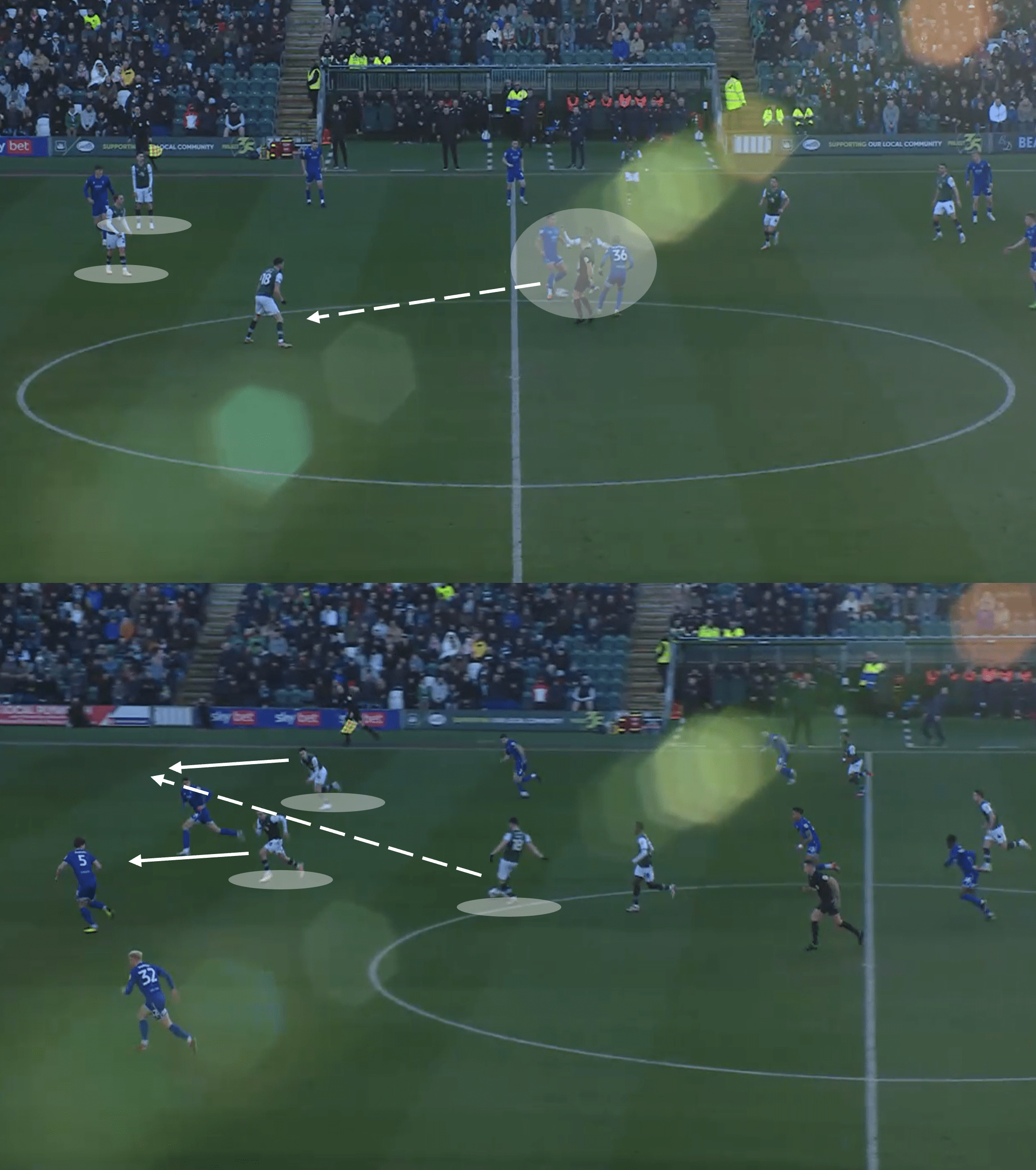
This first analysis is a strong example of scoring from nothing, being clinical and decisive in the final third.
The move starts with a 50/50 duel in the middle of the pitch, with the Argyle man prevailing and the ball finding its way to number 18, Finn Azaz.
An important part of this move, in particular, is that before Azaz even receives the pass, the teammates ahead of him begin to make forward runs in anticipation of the move unfolding as it did.
This kind of readiness and awareness have given Schumacher’s side a decisive edge so often this season, and it did so in this case, as Azaz wasted no time in playing the pass into the flank.

With the opposition clambering to regain some defensive organisation, Plymouth looks to strike.
They may not have a heavy presence in the final third, but their shape is still noteworthy—an attacker in the central area and one wide on the far side.
All good goalscorers ignore teammates from time to time, and that is what we saw here as the Argyle winger drove into the final third at pace, with the opposition defender clearly struggling to contain the eventual goalscorer.
He cuts inside onto his right foot and unleashes a powerful low shot past the keeper.
Plymouth Argyle XG Map
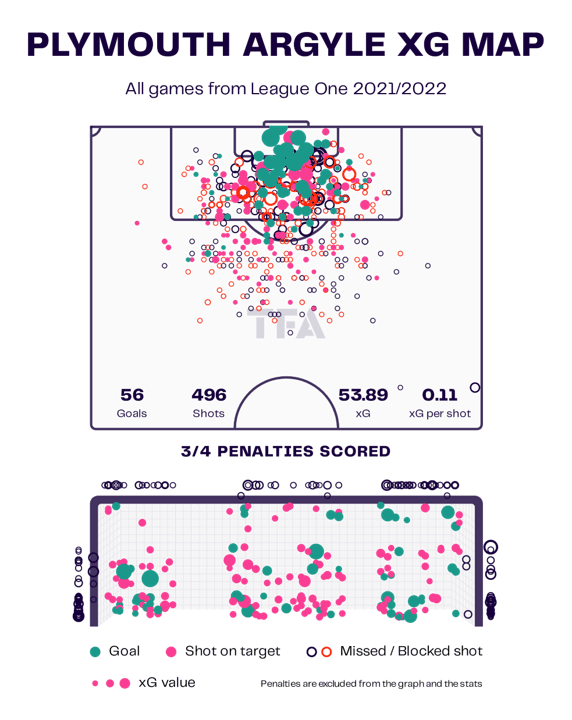
This xG map of Plymouth’s season gives us a bit more context about their proficient ways of attack.
They’ve scored 56 non-penalty goals despite having an xG of 53.89, so, as we touched upon before, they are scoring more goals than you would expect based on the chances they are creating – a sign of a clinical team.
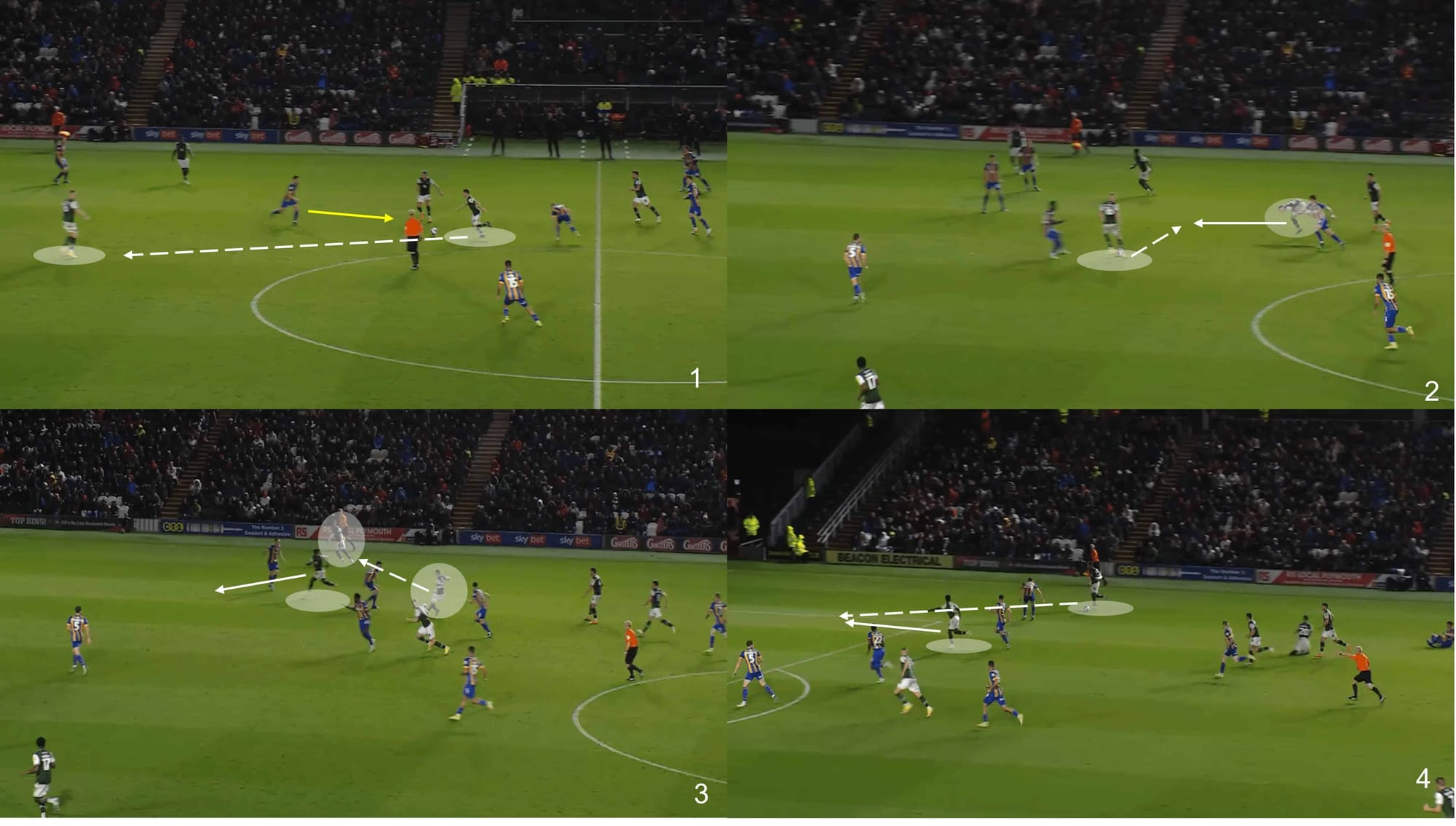
Here, we break down a quick sequence of play from Argyle that ended up in another impressive team goal.
Like the last move, this one starts with the midfielder needing to win his physical battle to get the ball forward—something Argyle is very good at.
They quickly shift the ball into the wide area, as they have done in many attacks.
However, as you will see from the map below, wing play is not Plymouth’s primary source of goals.
They attack these areas when the opposition fails to defend them adequately.
A clever sequence of passes results in Niall Ennis receiving the ball in the box at a difficult angle, but he laces the ball across the keeper to wrap up a quickfire attack from his team.
Plymouth Argyle Shot Assists Map

So as you can see from Plymouth’s shot assist map of the season, they don’t score a huge number of goals from wide areas – the right flank in particular.
Many of their assists seem to come from central areas of midfield or short passes inside the box, with the occasional delivery from a wide position.
Interestingly, like their xG, they are also currently surpassing their xA of 24.26 by some distance with 30 total assists!
A chink in the armour: defending wide attacks
A team this good in attack at the League One level was always going to have shortcomings somewhere, and that shortcoming was in defence.
While Plymouth aren’t awful defensively, they do currently have the worst record in the top six, conceding 29 goals so far.
While this alone is no area for significant concern, they should turn their attention to dealing with attacks from wide areas, as they seem to ship a fair few from these positions.
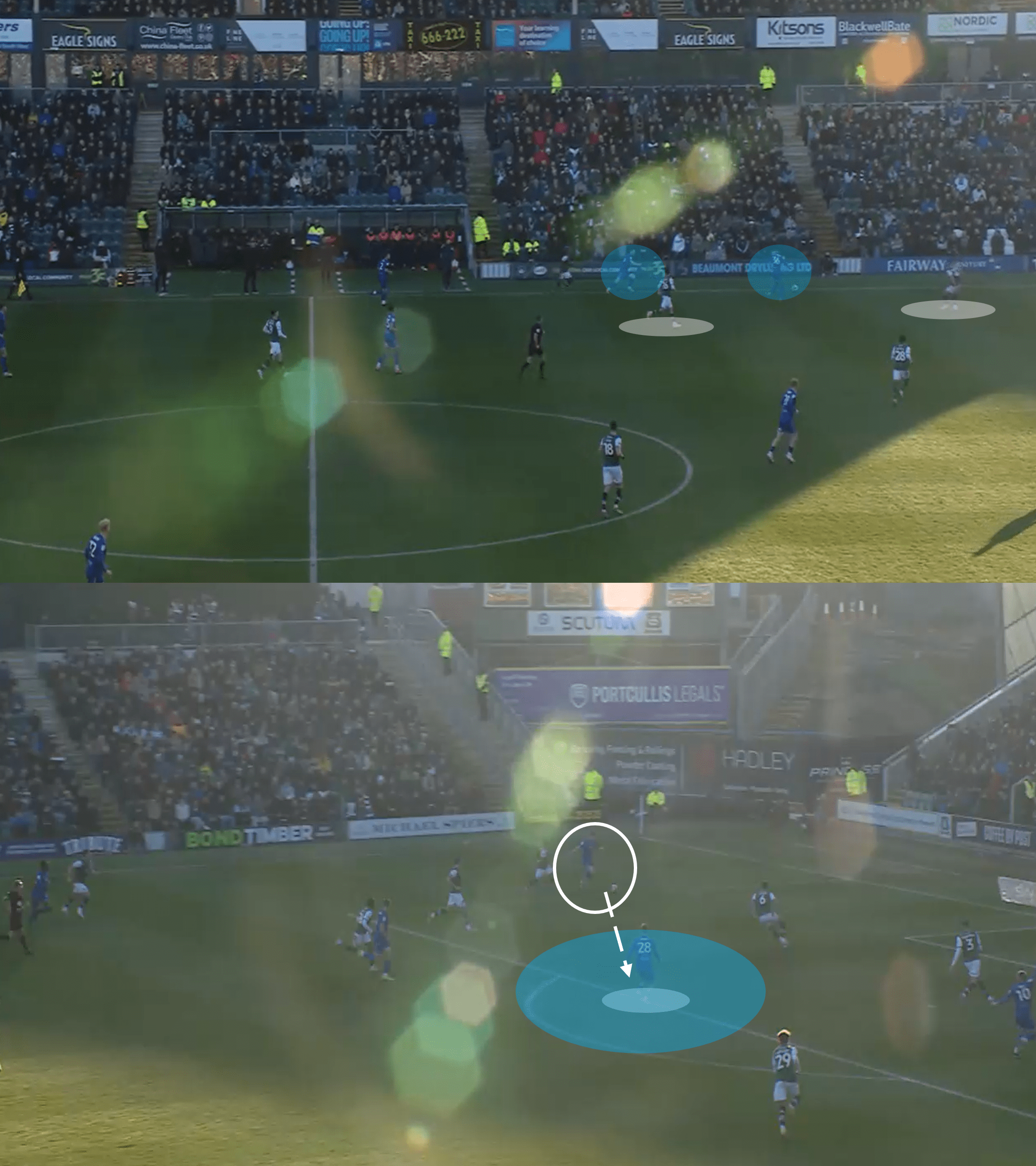
While it may be difficult to make out due to the light affecting the camera shot, this analysis above gives us some idea as to why they struggle to defend wide attacks.
It often comes down to what happens in the build-up to the final cross/pass.
The opponent on the ball in the first image is overlapped by his teammate, with the pass meeting the overlapping player.
This is where the first issue arises as the Argyle wing-back rushes out to close the first man down, leaving the second man free to receive the ball in space.
He drives forward despite pressure from Plymouth but he shows some quality to carry the ball at speed.
He then finds a teammate in a central area – unmarked despite the defensive presence, with the move resulting in a goal.
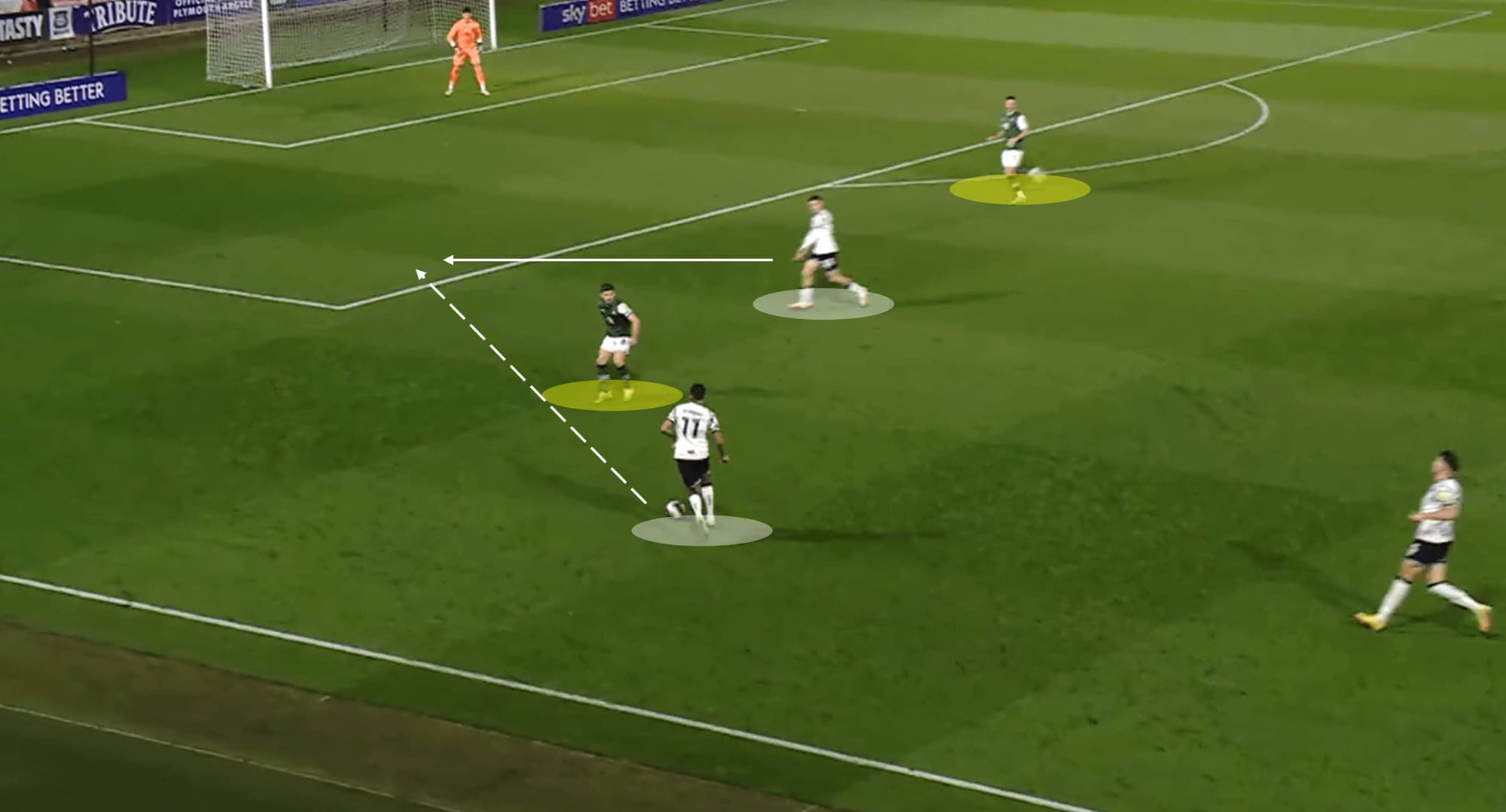
This move occurred after a transition, hence the lack of presence from Plymouth, but it is still a goal that ultimately could have been avoided.
The opposition player on the flank has time and knows the Plymouth defender cannot close him down as he risks leaving space behind, so he plays the early pass into the path of his teammate.
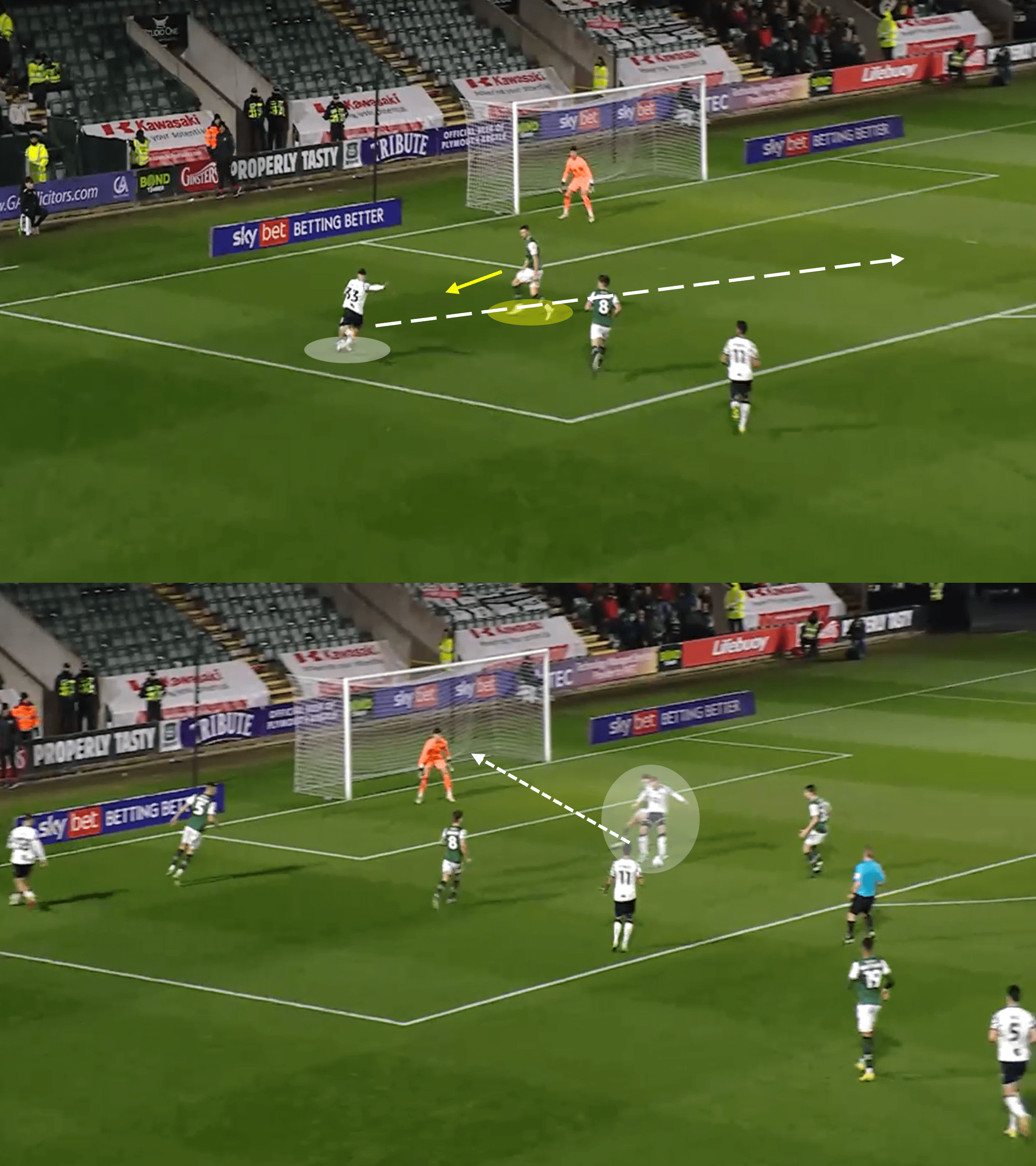
The same CB we mentioned from the first image attempts to get across to the opponent but simply isn’t quick enough, and the low cross finds an opposition striker.
The forward is marked, but he pins his marker and is able to shoot with his back to goal all too easily.
While it is understandable that Argyle didn’t want to concede a penalty, you cannot allow a play to score when he never faced the goal once.
A slow reaction from Plymouth to reorganise defensively didn’t help, but the goal was preventable anyway.
Conclusion
Plymouth have been a joy to watch this season, as have many teams in the EFL League One.
They have opted for a system of short passes to play through the thirds when they can, yet they don’t require possession dominance to make it work.
The fluidity and clinical nature of the attack stem from the players’ belief in Steven Schumacher’s tactics. They have been clever in varying their plays going forward based on the scenario at hand.
Defensively, there is room for improvement.
Whether it is down to the tactics or individual quality, Schumacher will know best and may wish to strengthen in that area whether they are promoted or not.
Despite the gap between Plymouth and the playoffs, they will know nothing is guaranteed yet—not even close—but looking from the outside, you have to fancy their chances based on their style of play and impressive attacking record.

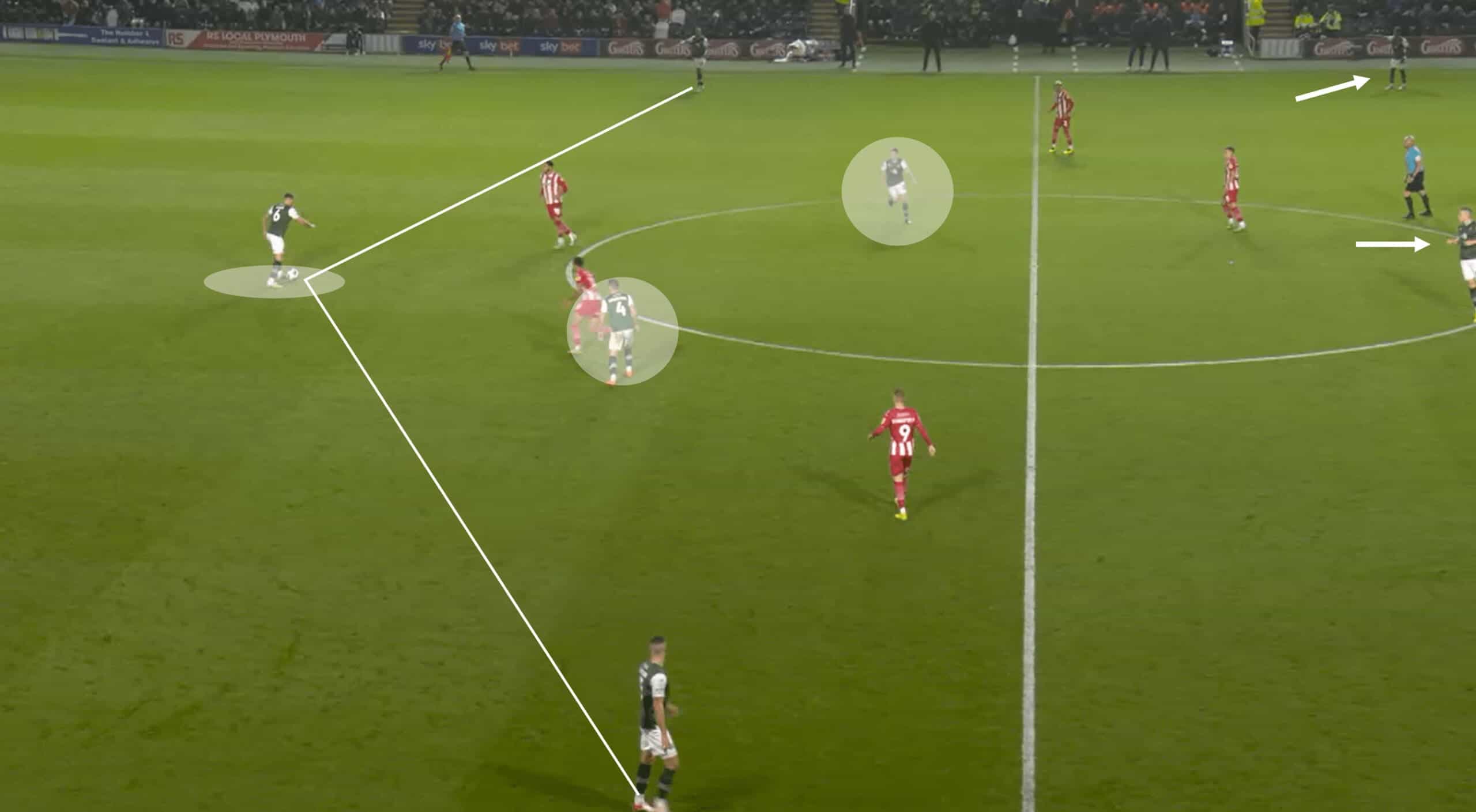




Comments